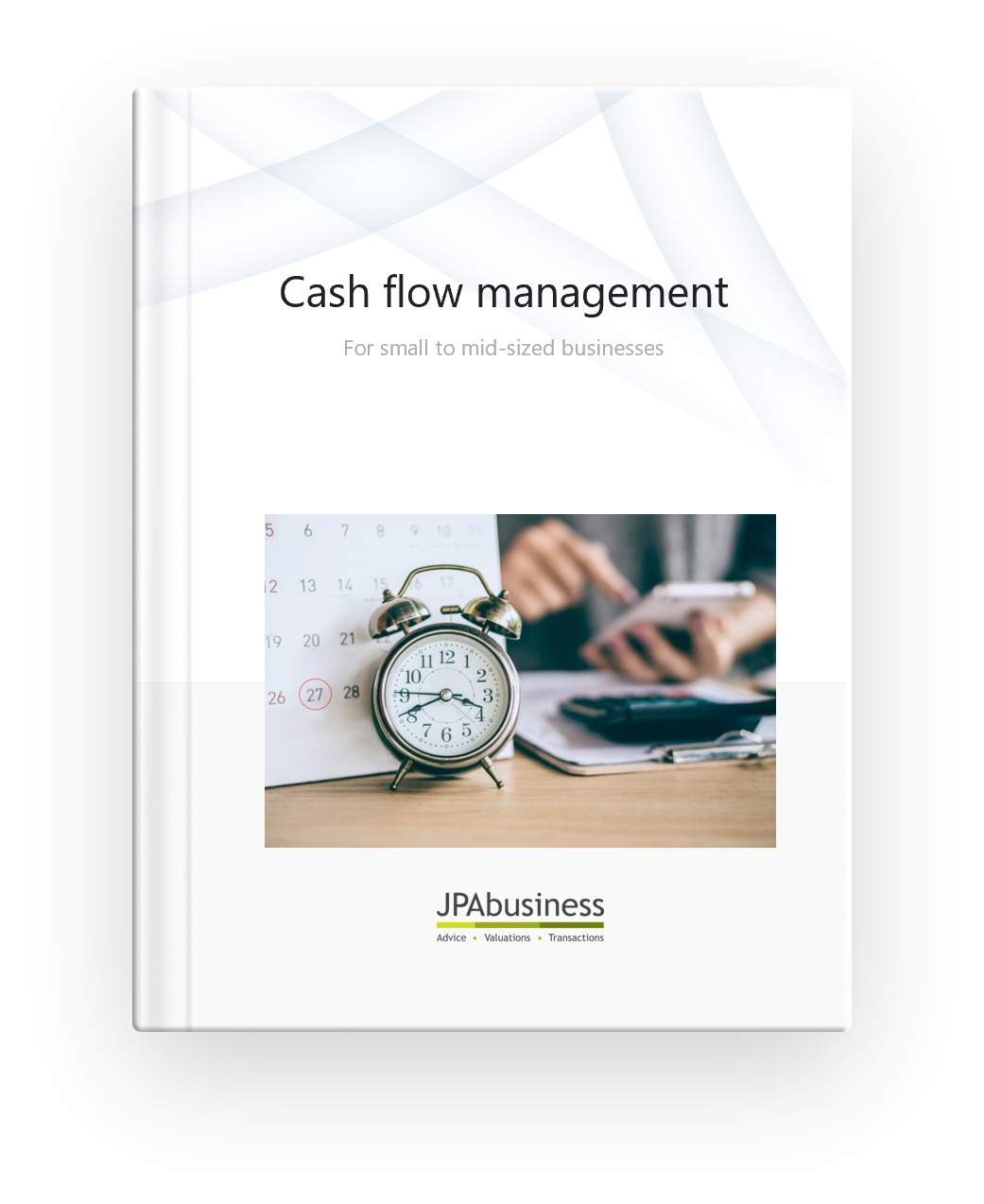Cash flow management for small to mid-sized businesses was written post the GFC, because we saw cash flow management as an important success factor for our clients in managing the dynamics of their businesses in a challenging environment.
We recently completed the transaction on a business sale for a client and it served as a reminder of how important both cash flow and working capital are to the success of a business.
In particular, it reminded us how important they are to building business value and therefore, when exiting a business, receiving value from the marketplace.
The levers that impact cash flow and working capital are critical to running a successful business day to day, but they are also critical to building business value over time.
A lot of money can be made or lost based on your inventory management, as our recent experience proved.
First up though, a couple of definitions...
Cash flow
Cash flow refers to the amount of surplus or deficit cash a business generates within a specified period of time.
Cash flow is almost never equal to net profit as companies tend to sell on credit and borrow money.
Furthermore, the cash generated through sales can be reinvested in the business or other assets, such as real estate, shares and interest-bearing investments.
Therefore, your accountant or advisor cannot simply compare the cash at hand at the beginning and end of the accounting period to determine cash flow.
Instead, they prepare a special report, called the Statement of Cash Flows.
Working capital
Working capital is the difference between a business’ current assets (e.g. debtors, inventory, etc.) and current liabilities (e.g. creditors, short-term lines of credit, ATO and employment liabilities).
In accounting and finance, the term ‘current’ refers to assets that can be turned into cash, or liabilities that are due in less than 12 months.
Because both figures are stated in the balance sheet of a company or firm, the calculation of working capital is a simple task.
A large amount of working capital means the current assets of the company are more than sufficient to cover current liabilities that are soon due.
Negative working capital means the company may not be able to pay upcoming bills with the amount of money, soon-to-be-collectable receivables and other assets, it holds that can be turned into cash on short notice.
Case study: Paying the price of poor inventory management
Recently we were involved in facilitating the sale of a strong, independent business involved in import and distribution.
It was a well-known, independent brand that had been established for well over 50 years. It had a lot of history and solid bottom-line performance.
Overall the business was successful in delivering what it promised to its customers and had been successful in delivering value to its owner day to day.
Unfortunately, when it came time to exit the business and realise its value in the marketplace, there were a few legacy issues that provided some difficult negotiation challenges.
Costly legacies
Sometimes, many years in business delivers great benefits – and it had for this business – but it also leaves some less positive legacies.
One of the legacies that was very clear in selling this business was the amount of inventory (stock on hand) – it was very significant.
We negotiated a price for the goodwill, plant and equipment etc, based on a multiple of Business Maintainable Earnings (BME), which is essentially the cash flow of the business.
Then it was time to address the stock value.
Usually stock on hand is valued by way of a stocktake and its value is paid by the purchaser at completion.
Ideally, its agreed value is the buy price the vendor paid for the stock at the time of the original purchase.
In this case, and unfortunately this is something we are seeing quite often in business sale transactions, there was considerable disagreement about the value of the stock on hand – a difference of 50%.
The buyer basically said: “You have X amount of stock, but a reasonable level of stock to run this business is Y. I don’t need X amount so I won’t pay for it. I will pay for Y.”
Beauty (of stock) in the eye of the beholder
Often people who are not adept at managing inventory will have excess stock because it feels good to know they have it in case someone wants to buy it.
However, they don’t necessarily think about the value of it.
In the meantime the stock may be diminishing in value but, as purchasers often joke, the vendor thinks they have ‘gold’ sitting on the shelf or in the warehouse.
As a vendor you may say: “I’ve been in this business for many years. If you don’t have the stock you can’t sell it. Therefore I would rather have this stock holding than run short.”
That’s fine. You’ve been in the business for years and understand the cycles, but the purchaser is just looking at the figures on paper and it seems too much. Chances are they’ll go with their calculation, and often times this is also being supported by their advisor.
Beauty is in the eye of the beholder when it comes to stock value and sometimes that is a very difficult concept to accept during a sale process.
Too little stock also costly
There is, of course, a balancing view point, which is important to consider: a business that is low on stock is often one that doesn’t maximise its product sale opportunities.
Therefore a purchaser should always listen closely to an owner when they talk about stock turn and inventory levels – these are not black and white issues and every business owner will have a different approach to their inventory level. These approaches mirror an owner’s risk appetite and way of doing business.
There is no right or wrong, but there are significant consequences for decisions about inventory levels.
A timely reminder
The disagreement between vendor and purchaser outlined above represented a large reduction in the value of the business to the vendor – several hundred thousand dollars.
It also meant the cash flow the owner had diverted to stock holdings over the years was lost – he couldn’t get that value back out.
This experience was a timely reminder to me that business owners who do not actively manage their inventory holdings will find it comes home to roost when they sell.
If only that inventory had been more closely managed, the business owner, on exiting the business, would have actually got the value of that inventory back. They would have realised it either in the purchase price for the stock sold, or in getting the cash flow back out of the inventory when they were managing it day to day.
It heightened my awareness and made me keen to warn other business owners: “Don’t forget inventory, because there’s big dollars to be won or lost there as a business owner."
How stock holdings are valued
A purchaser will value your stock holding based on a calculation of your sales over a particular period.
They may look at the dollar value of sales you have made in the past six months or 12 months, then reference that dollar figure against the level of stock.
For example, you have made $250,000 worth of sales of item A in the past 12 months. However the value of stock on hand of item A is $350,000.
In your industry, a stock holding that represents 12 months’ worth of sales may be the maximum you need.
In that case, why would they pay for $350,000 worth of stock when they only need and want $250,000 worth for their first 12 months of trading?
How to ensure your stock holding maintains its value
Inventory can provide positive cash flow, but only if it is managed like a share portfolio.
For example, most people who have shares will actively look at what those shares are worth on a daily, weekly or monthly basis to see how they are trading versus the market.
If the shares are underperforming, they will be sold.
Similarly, inventory must be closely managed and moved on when necessary.
Don’t be tempted to sell off excess stock quickly
Simply planning to reduce your stock level just before selling your business, however, is not a good option.
This will reduce the margin on the items sold and create a sudden reduction in your gross profit, which will negatively impact the Business Maintainable Earnings (BME).
As we've discussed in other ebooks, BME is a key consideration when assessing business value.
Rather than losing money on the stock, you will lose money from the business price.
If you have over-stock or obsolete stock items, they must be sold off gradually, over an appropriate period of time.
If you would like advice about managing your inventory holdings, contact the team at JPAbusiness on 02 6360 0360 or 02 9893 1803 for a confidential discussion.


